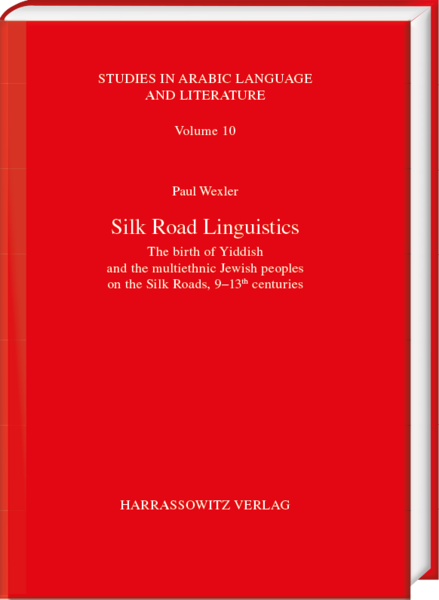Silk Road Linguistics: The birth of Yiddish and the multiethnic Jewish peoples on the Silk Roads, 9–13th centuries. The indispensable role of the Arabs, Chinese, Germans, Iranians, Slavs and Turks
 In this comprehensive study Paul Wexler demonstrates that Yiddish is a Slavic language largely relexified to genuine and artificial German and Hebrew, as a cryptic language of trade in the Khazar Empire in the 9–10th centuries for the use of multilingual Jewish merchants, who enjoyed special privileges on the Afro-Eurasian Silk Roads until the 13th century. Other Judaized trade languages (Turkic, Chinese, Arabic) were also coined at this time in the Khazar and Iranian Empires. In both empires, Yiddish absorbed over 5,000 overt influ-ences mainly from Judaized Persian, and secondarily from Judaized Turkic and Chinese. Yiddish mainly has Hebraisms wherever Persian employs Arabisms (but has almost no overt Arabisms) and preserves Asianisms with greater accuracy and volume than most Iranianized non-Jewish target languages. Until c. 1000, almost all Jews in the world resided in the Iranian Empire and were mainly of Iranian and only partly of Palestinian Judaean descent. Conversion to Judaism was common among Iranians, Turks, Slavs and Berbers (because of a desire to participate in the lucrative Silk Road trade dominated by Jews, and to escape the status of slavery often imposed on them); conversion led to the rise of new diverse Jewish “ethnicities” and forms of Judaism. The book also examines the Iranianization of other cryptic Jewish trade languages, of Slavic and German, and the common Hebrew-like lexicon used by all Jewish merchants to overcome varied language backgrounds. Yiddish can help to reconstruct the Iranian speech of mixed Irano-Slavic confederations (such as the Galician White Croats).
In this comprehensive study Paul Wexler demonstrates that Yiddish is a Slavic language largely relexified to genuine and artificial German and Hebrew, as a cryptic language of trade in the Khazar Empire in the 9–10th centuries for the use of multilingual Jewish merchants, who enjoyed special privileges on the Afro-Eurasian Silk Roads until the 13th century. Other Judaized trade languages (Turkic, Chinese, Arabic) were also coined at this time in the Khazar and Iranian Empires. In both empires, Yiddish absorbed over 5,000 overt influ-ences mainly from Judaized Persian, and secondarily from Judaized Turkic and Chinese. Yiddish mainly has Hebraisms wherever Persian employs Arabisms (but has almost no overt Arabisms) and preserves Asianisms with greater accuracy and volume than most Iranianized non-Jewish target languages. Until c. 1000, almost all Jews in the world resided in the Iranian Empire and were mainly of Iranian and only partly of Palestinian Judaean descent. Conversion to Judaism was common among Iranians, Turks, Slavs and Berbers (because of a desire to participate in the lucrative Silk Road trade dominated by Jews, and to escape the status of slavery often imposed on them); conversion led to the rise of new diverse Jewish “ethnicities” and forms of Judaism. The book also examines the Iranianization of other cryptic Jewish trade languages, of Slavic and German, and the common Hebrew-like lexicon used by all Jewish merchants to overcome varied language backgrounds. Yiddish can help to reconstruct the Iranian speech of mixed Irano-Slavic confederations (such as the Galician White Croats).
zum Buch im ULB-KatalogPlus
zum Buch auf der Verlags-Website
Language and gesture in Chinese conversation
 Language and Gesture in Chinese Conversation is a study of the semantic and temporal relationships between the speech and the gesture in the context of discourse interaction in Mandarin Chinese spoken in Taiwan. The cross-modal representation of ideas in natural discourse reveals the nature of BISHOU-SHUOHUÀ in the communication of meaning.
Language and Gesture in Chinese Conversation is a study of the semantic and temporal relationships between the speech and the gesture in the context of discourse interaction in Mandarin Chinese spoken in Taiwan. The cross-modal representation of ideas in natural discourse reveals the nature of BISHOU-SHUOHUÀ in the communication of meaning.
The study addresses two central issues: How do language and gesture represent the semantic information of various types of ideas? How do the linguistic representation and gestural depiction pattern temporally in the communication of cross-modal information?
The intended audience of this book are scholars in many academic fields, including linguistics, language and gesture, human communication, cognition, cognitive neuroscience, social psychology, sociology, linguistic anthropology, speech pathology, and speech therapy.
zum Buch im ULB-KatalogPlus
zum Buch auf der Verlags-Website
